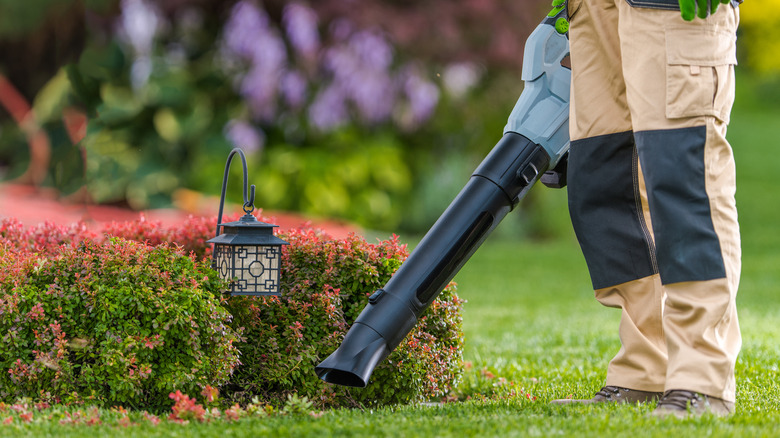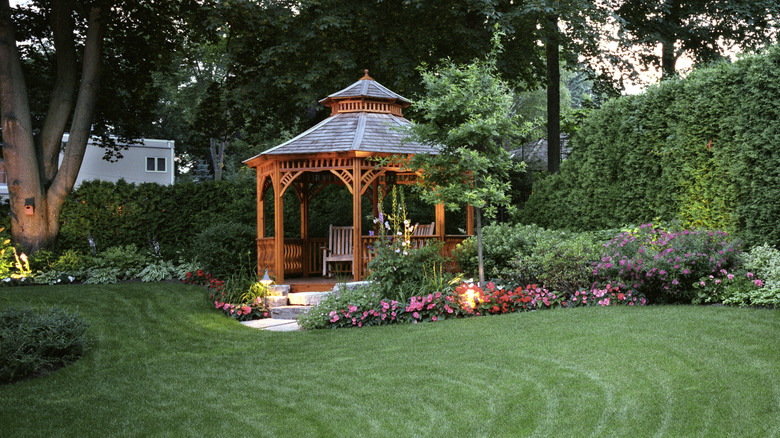Could This Smart Appliance Shortcut Make Overseeding Your Lawn A Breeze?
If your front yard is a messy patchwork quilt of crabgrass, it may be time to consider overseeding. Overseeding is the process of supplementing existing grass with additional seed in order to revitalize holes or patches and invigorate stronger lawn growth. Proper overseeding will spawn healthier grass with a more vibrant color that can resist invasive weeds. One recent TikTok trend suggests using a leaf blower to remove debris from your grass rather than painstakingly raking it out one back-breaking row at a time.
While this suggestion will help blow all those leaves, sticks, and gnomes away with the efficient power of your leaf blower, overseeding a lawn does nevertheless take a considerable amount of effort and patience. Still, a leaf blower will expedite the prepping process, so it may be worth swapping the task of raking with a leaf blower as it's fast, simple, and honestly just more fun.
How to reseed your lawn
Overseeding a lawn is a relatively easy process for those who have noticed a thinning in their grass and are looking to improve the overall health and color. If 50% of the lawn has healthy grass, overseeding is the best option. If not, you'll want to look into reseeding, which is the complete removal of what's growing and then restarting from just the soil.
Should overseeding be best for your lawn, consult a local nursery for the preferred seed options for your climate and sun coverage. Once you've purchased seed, the first step is to mow the existing grass to a short height. Next, put that TikTok hack to the test and blow away any grass clippings, leaves, or sticks that would create a barrier between the seed and soil. If you find that the blower is ineffective or the lawn has thatched areas, you'll want to give it a light raking to loosen up and aerate the soil then blow or rake away any debris that you unearth.
Once the lawn is prepped, spread the new grass seed over the soil using a seed spreader. After the new seed is down, fertilize and irrigate the soil immediately so that the seeds can take root. It may take several weeks for the grass to become established. Be sure to water each day to keep the soil moist, preferably early in the morning or late in the evening to prevent evaporation or sun damage.
Maintaining a healthy new lawn
Avoid mowing a new lawn until the seedlings have reached at least two to three inches in height. Be sure to mow it higher, trimming just the top third in order to preserve the roots and prevent stress. It's also a good idea to alternate the mowing pattern of your lawn to limit compacting the new grass. A sharp blade can also improve the quality of your grass, so it's important to have your lawn mower blades sharpened at least once per season.
Once the new grass is firmly established, watering the lawn twice per week should suffice. Increase the time spent watering the grass but reduce the frequency — thirty to sixty minutes is typically enough time to efficiently hydrate. Remember, though, to account for rain to prevent fungus from developing on a waterlogged lawn.
Keeping up a healthy verdant lawn takes care, so be sure to fertilize a new lawn to facilitate deep root growth. Choose the right fertilizer for your lawn type and climate and follow the directions carefully. Fertilize cool-season grasses in the fall when their growing season is at its peak while you should fertilize warm-season grasses in the spring. As your lawn matures over the years, consider other methods of maintaining a healthy green glow by topdressing or filling in holes with topsoil.

